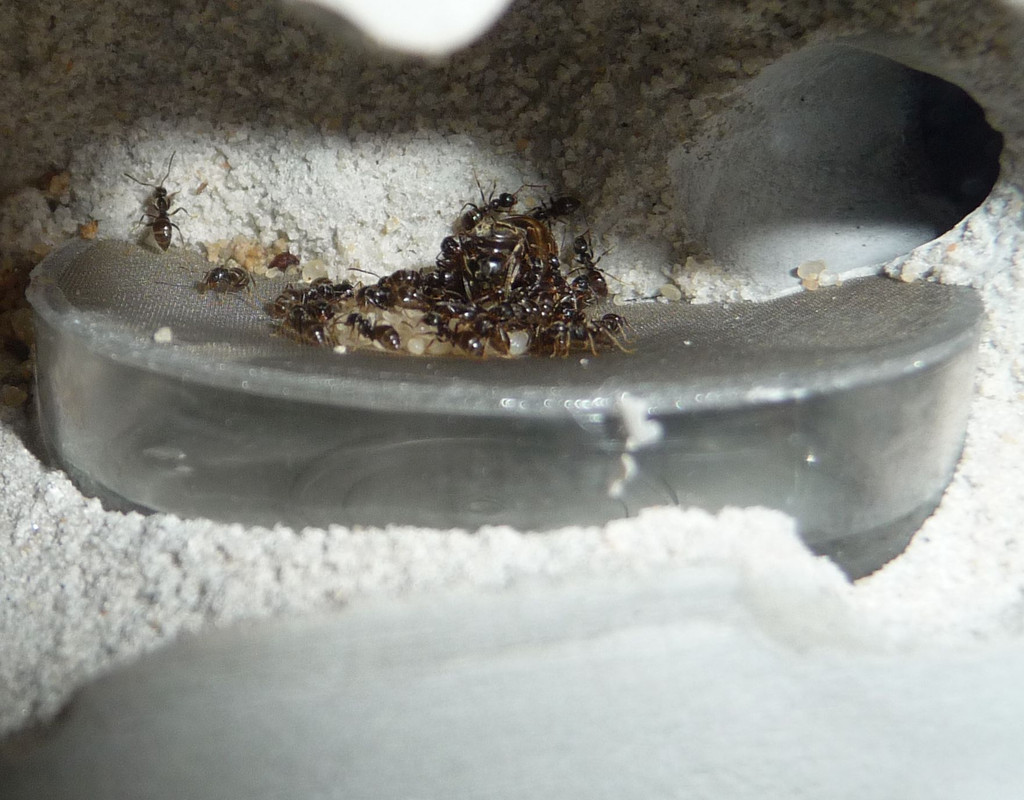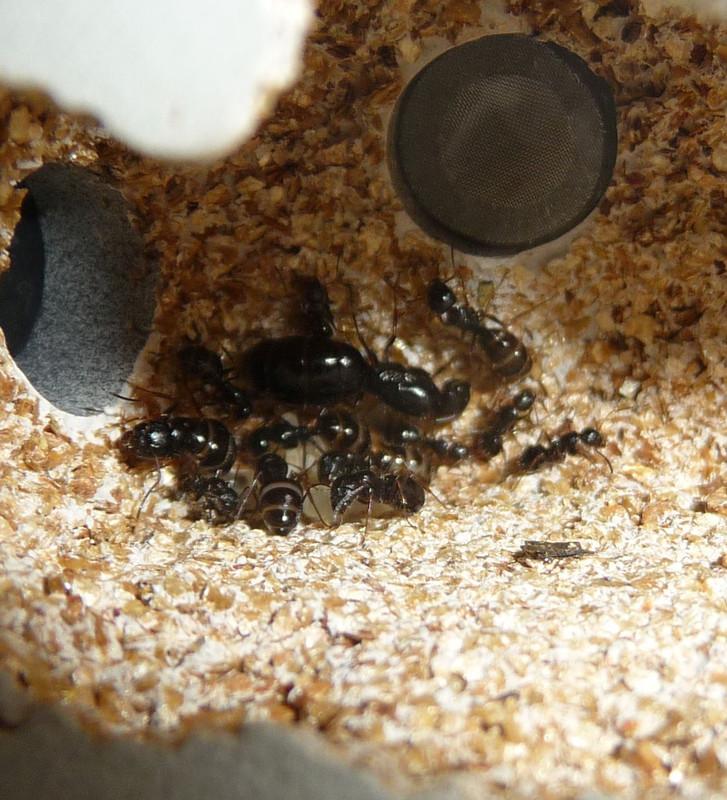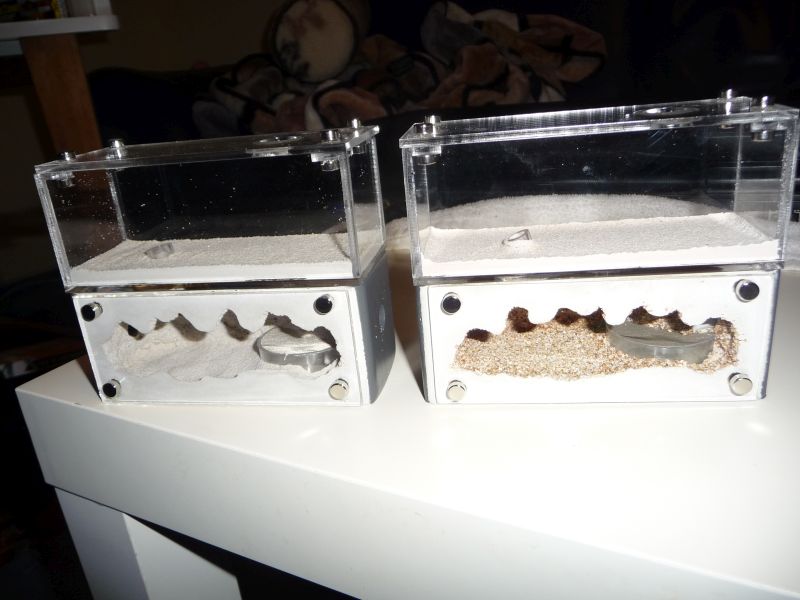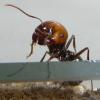






I do not put water in my Camponotus pennsylvanicus and Camponotus Discolor at all. If they have access to water in their outworld through a test tube with water or a water feeder they are less likely to need a water source in their nest. Your careful observations of how your ants are reacting to the gradient you have offered them is the right way to go IMO. Try only filling the water tower 1/4 full for a bit and offer them a test tube with water in the outworld (or a quality water feeder) It's important that the water source in their outworld is useable by the ants (some feeders don't work for some species of ants, I think the idea of hydrating nests came about due to too many keepers killing their colonies by having water feeders that just didn't work reliably and consistently-- many ants are fine with a dry nest... provided they can collect water at all times) So it should be not something that can clog, or flood or break. I'm pretty picky about water feeders and only really like ByFormica's products OR a test tube filled with water and blocked with cotton. There are a few other water feeders that I can get to work by modifying them, adding cotton, or a screen in some cases, but many off the shelf feeders just don't work well out of the box.
The downside to offering a test tube is they may choose to move in to it if the colony is small. But that would also be the ants telling you something about their needs. (that they prefer a test tube to the nest.)
I like to offer a test tube almost as a back up. Test tubes with cotton are very reliable and it's hard to go wrong.
Another factor in they way they are clustered may be light. Lasius are not very light sensitive and have very poor eyesight and small eyes. Carpenter ants have better (but still not great) eyesight but can be very sensitive to light. They may be in that location because it's darkest? This would depend on your lighting. Do you keep your nests covered or are they always exposed to light when the lights are on in the room?
Beautiful colonies and photos!
Starting this July I'm posting videos of my ants every week on youTube.
I like to make relaxing videos that capture the joy of watching ants.
If that sounds like your kind of thing... follow me >here<.
I do not put water in my Camponotus pennsylvanicus and Camponotus Discolor at all. If they have access to water in their outworld through a test tube with water or a water feeder they are less likely to need a water source in their nest. Your careful observations of how your ants are reacting to the gradient you have offered them is the right way to go IMO. Try only filling the water tower 1/4 full for a bit and offer them a test tube with water in the outworld (or a quality water feeder) It's important that the water source in their outworld is useable by the ants (some feeders don't work for some species of ants, I think the idea of hydrating nests came about due to too many keepers killing their colonies by having water feeders that just didn't work reliably and consistently-- many ants are fine with a dry nest... provided they can collect water at all times) So it should be not something that can clog, or flood or break. I'm pretty picky about water feeders and only really like ByFormica's products OR a test tube filled with water and blocked with cotton. There are a few other water feeders that I can get to work by modifying them, adding cotton, or a screen in some cases, but many off the shelf feeders just don't work well out of the box.
The downside to offering a test tube is they may choose to move in to it if the colony is small. But that would also be the ants telling you something about their needs. (that they prefer a test tube to the nest.)
I like to offer a test tube almost as a back up. Test tubes with cotton are very reliable and it's hard to go wrong.
Another factor in they way they are clustered may be light. Lasius are not very light sensitive and have very poor eyesight and small eyes. Carpenter ants have better (but still not great) eyesight but can be very sensitive to light. They may be in that location because it's darkest? This would depend on your lighting. Do you keep your nests covered or are they always exposed to light when the lights are on in the room?
Beautiful colonies and photos!
Thank you for your input!
This is very valuable!
This is what I thought, when the water has evaporated, I will see how they go and will not refill it (except if they respond with unhealthy behaviour).
I have test tubes in the small outworlds, I also think they are the most reliable. The colony has not made any move to move back into the test tube, so this appears to be okay. In any case, I have a selection of ByFormica water-feeders on hand, should the need arise. I also think the ByFormica ones are the best, I tried several different brands so far.
This is how the setup looks like (picture taken after I put the colony in, they moved into the nest below in just 30mins):


Edit:
And yes, the nests are covered with a red cover, and the shelf they are on are in a darker corner of my living room, where direct sunlight does not reach.

Edited by Ernteameise, March 29 2024 - 4:10 AM.
I would keep the test tubes in the outworld and water the tower 1/4 of the way as they are already getting water from the tube.
Currently keeping: 2 C.vicinus colonies.2 C.sansabeanus. 1 C.leavissimus. 2 C.Ca02. 1 V.pergandei. 4 T.immigrans.1 F.pacifica. 1 C.hyatti
1 M.ergatognya
Trying to get my hands on :C.modoc,A.vercicolor, and Any Honeypots
Edited by Artisan_Ants, March 29 2024 - 6:53 AM.
Keeping:
3x - S. molesta (colonies and single queen) 1x - C. nearcticus (founding but no eggs) ![]() New!
New!
1x - C. chromaiodes (colony) 1x - C. subbarbatus (founding)
1x - F. subsericea (founding) 1x - T. sessile (mega colony)
3x - P. imparis (colonies)
2x - L. neoniger (founding)
Check out my C. nearcticus journal here: https://www.formicul...cticus-journal/
Check out my C. chromaiodes journal here: https://www.formicul...aiodes-journal/
0 members, 1 guests, 0 anonymous users